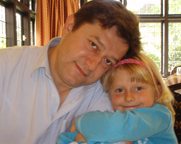Not many people get to spend their careers involved with something they’ve loved since they were 10 years old.
University of Kentucky alum Zeljko Ivezic is one of those lucky few. The Croatia native became fascinated with what he could see in the sky and beyond as a child and now Ivezic is a leading astronomer at the University of Washington in Seattle.
 Having had a hand in creating the very first digital map of the sky, Ivezic continues to follow his passion, working on several projects including one that could help to identify dangerous asteroids that might strike our planet.
Having had a hand in creating the very first digital map of the sky, Ivezic continues to follow his passion, working on several projects including one that could help to identify dangerous asteroids that might strike our planet.
Ivezic, 44, earned undergraduate degrees in physics and mechanical engineering from Croatia’s University of Zagreb in 1991.
“But I knew I wanted to go to school in the U.S. for my graduate studies,” Ivezic said. “I always knew that’s what I wanted.”
He applied to UK somewhat by chance.
“I had to choose four schools that would get sent my GRE scores,” he said. “I did the obvious ones, MIT, Berkley and Harvard, and then I had to pick the last one. I picked UK because I was drinking some Kentucky bourbon while I was deciding.”
While he couldn’t have guessed he’d end up in Lexington, Ivezic said UK was a great choice.
“It was a great thing I found at Kentucky,” he said. “I think Kentucky stands out with the warmth of the people there. My advisors opened doors to me. I was concerned at first that I would not have as many opportunities as at other schools I had considered but UK gives you sufficient education and experience when compared to other schools. It’s the same quality and it was a good choice for me.”
While at UK, Ivezic and a couple other students developed a radiative transfer code they named DUSTY. DUSTY can help researchers process models of radiation that comes from stars and other sources even when the radiation is affected by a dusty region in space. The code has been used in a number of published papers.
Ivezic also met his wife, Pamela, while at UK. She was a graduate student in the department of music. The couple has a nine-year-old daughter, Vedrana.
He was involved in the Lexington community outside the UK campus, too.
An immigrant himself, Ivezic, and his wife Pam helped people who had fled from war-torn Bosnia.
“We helped with language and settling in,” he said. “It was very fulfilling to see people come from war and start new lives here.”
After five years at UK, including his post doctoral work, Ivezic and his family moved on to New Jersey where he began working at Princeton University.
During his seven years at Princeton, Ivezic participated in the Sloan Digital Sky Survey which has been called one of the most ambitious and influential surveys in astronomy history. Over the course of eight years, the survey produced three-dimensional maps of more than 930,000 galaxies.
When a faculty position opened at the University of Washington, Ivezic and his family headed west but his focus has not changed much.
In what he calls a “next generation job,” Ivezic is now part of an effort to create the first digital movie of the sky with the Large Synoptic Survey Telescope.
The Large Synoptic Survey Telescope is a new type of telescope that can detect faint objects with short exposures and move quickly between images, allowing astronomers to observe large areas of sky at once. It can take more than 800 panoramic images each night, meaning it can cover the sky twice each week.
“What took us months before, takes us just days now,” he said. “The technology has changed a great deal. Every couple of nights we are able to create these movies and then compare what we see now with what we saw a couple days or weeks ago.”
Ivezic and the other scientists can use what they learn with the telescope to detect and track potentially dangerous asteroids that could hit the Earth.
The work and impact involved with the field of astronomy is still intensely satisfying, even decades after Ivezic first looked upward and onward.
“They’re such big questions we’re trying to answer in the field,” he said. “What are we made of? What is our Earth and space made of? What do those things mean to life?”
by Sara Cunningham
